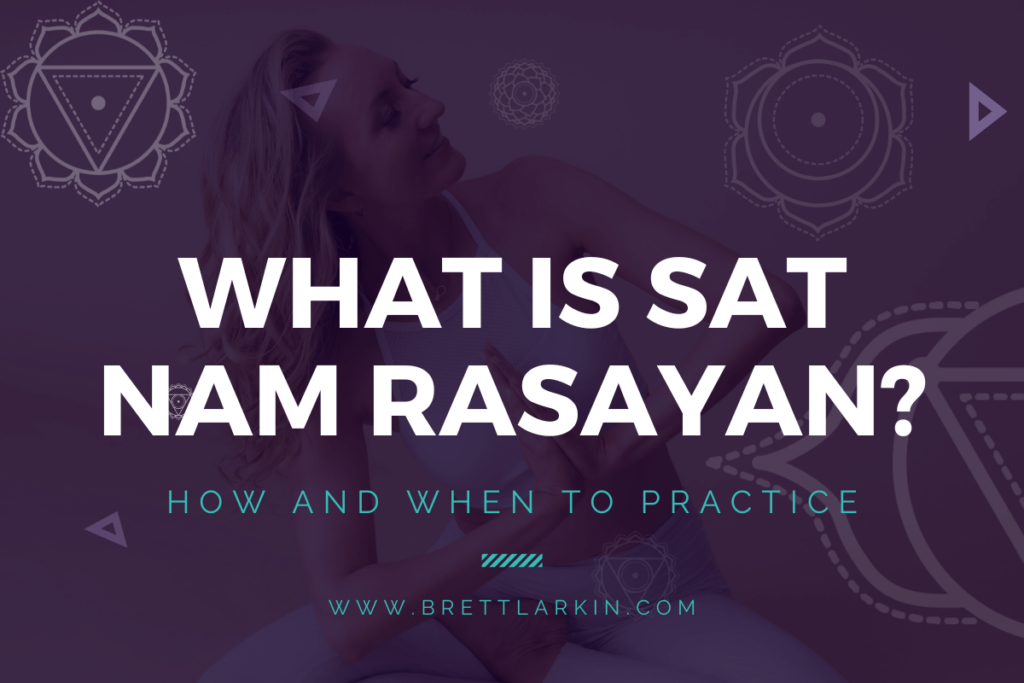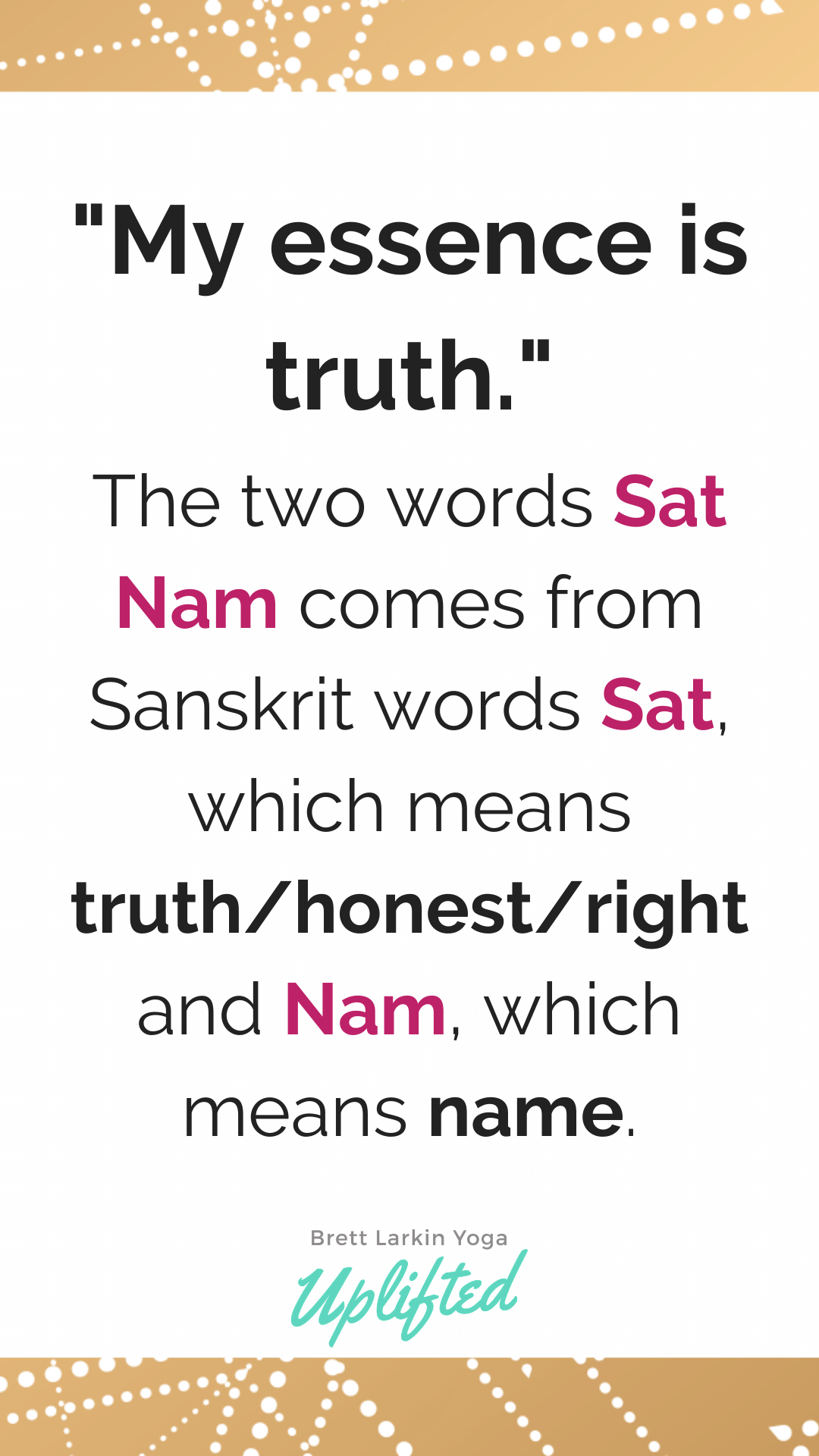Do you believe that your thoughts have an impact on your body and health?
Within the Kundalini yoga tradition exists a specific healing modality called Sat Nam Rasayan. Through meditation, your mind comes to a neutral state of clarity in which healing can occur. It’s believed that Sat Nam Rasayan works on a subtle energy level through the projective meditative mind.
Are you ready to learn about this practice believed to restore vitality, balance and health?
What Is Sat Nam Rasayan?
Sat Nam Rasayan is a healing practice with roots in the Kundalini yoga tradition that is often translated to mean “deep relaxation in the true identity” or “deep relaxation in the Divine Name.” The exact origins of this practice are unknown. Through meditation, a practitioner enters a state of consciousness called shuniya that is said to be a neutral meditative state of stillness, and profound peace. Shuniya, which translates to “zero”, is similar to samadhi which is outlined in Patanjali’s eight limbed path of yoga. Shuniya is essentially a state of profound inner silence.
The ancient healing art of Satnam Rasayan is healing through awareness. Now, this isn’t focused awareness on something you want to change or heal, but instead relaxed awareness that makes way for the body to heal itself. By maintaining a state of “zero”, or emptiness, you attune to the source of all things and reaffirm that you are not a separate human being from source. Once in a state of shuniya, the Divine, or source, is able flow through your body freely.
In this deep meditative state, consciousness shifts which makes it possible for blockages and resistances to dissipate, or transform. In many cases, these blockages are actually only self imposed limitations. You’re able to tap into the subtle energies of your body and create a healing space. Your body’s innate ability to heal itself can function more optimally.
It can take many years of training and practice for someone learning Sat Nam Rasayan to reach and maintain a state of shuniya. Often, Sat Nam Rasayan is performed in a therapeutic setting or sacred space and the state of shuniya is held by a healer or experienced teachers for others to benefit from it and heal.
Performed in this way, Sat Nam Rasayan reinforces the idea that all people are connected to each other through loving energy. It reinforces the idea of the universal self.
History of Sat Nam Rasayan
It is said that for thousands of years, Sat Nam Rasayan was taught directly from teacher to student in silence. Students would learn by exposure to their teacher’s aura and psychic influence. Over many years, training continued until a student could reach and maintain a state of shuniya. Once the teacher was able to witness a student’s ability to maintain a state of shuniya, the student would become a teacher and a healer of others.
It wasn’t until Yogi Bhajan taught Sat Nam Rasayan to Guru Dev Singh and tasked him with sharing it widely that the practice took a written and more formally taught form. Guru Dev Singh went on to establish the Sat Nam Rasayan International School.
Satnam meaning
If you’ve practiced Kundalini yoga before you’ve probably heard the mantra Sat Nam in class. It is one of the most commonly used mantras in this yoga lineage. And for good reason! The Sanskrit word Sat means “truth/honest/right” and Nam means “name.” Together, Sat Nam translates to “I am the truth” or “My essence is truth.”
One of the main goals of the Kundalini yoga is to awaken your full capacity of human consciousness. You can think of it this way: to recognize your true identity. Repetition of the mantra Sat Nam is a strong and supportive reminder of this journey.
The mantra Sat Nam is used in many kriyas, such as Sat Kriya. It is even the default mantra for poses if another one is not specified. You’ll also find that most Kundalini practices close with this mantra.
Another Kundalini practice that I love for its ability to awaken your consciousness is Ek Ong Kar. The mantra Ek Ong Kar translates to “the creation of one God” and describes how you are a creation of the divine. YOU are divine.
Take my quiz to learn if YOUR kundalini energy is awakened 
Benefits Of Sat Nam Rasayan
Sat Nam Rasayan claims multiple benefits:
- Relaxation and calmness
- Stress Relief
- Emotional support: reduces fear, depression, and anger
- Encourages
- Mental clarity, concentration and focus
- Reduction in physical pain
- Assists the healing process for physical ailments
Similar to other forms of meditation, Sat Nam Rasayan is said to help people achieve a better sense of well-being, self knowledge, and balance in life.
Because Sat Nam Rasayan works in the neutral mind, it helps practitioners to release expectations. Judgement, criticism, and prejudices will naturally start to diminish. As they do, acceptance and compassion tend to take their place.
Are You Chanting Correctly? Refine Your Tune with Me! 

Are You Chanting Correctly? Refine Your Tune with Me!

When To Practice Sat Nam Rasayan
As a meditative practice, Sat Nam Rasayan can be practiced at any time. Balancing the energy body in a neutral place is an excellent health maintenance practice to incorporate into your lifestyle.
That being said, it is common for people to gravitate towards the practice when issues arise like illness, physical ailments, spiritual concerns, emotional problems, or issues in relationship dynamics.
How To Practice Sat Nam Rasayan
You can be trained in Sat Nam Rasayan or you can choose to have sessions facilitated by a trained practitioner.
A beautiful aspect of Sat Nam Rasayan healing is that by going to a place of stillness with shuniya, the practitioner does not need to discuss with the patient why they want to request healings. The practitioner instead just needs to access the neutral space of stillness. In this way the healer simply notices and helps to remove blocks or resistances (such as preconceptions, limits, or distractions) that stand in the way of the person’s ability to heal freely. The healing already exists within the person as one of many innate abilities.
To facilitate a Sat Nam Rasayan session, the ‘receiver’ lays down on their back and the ‘giver’ gently places a hand on the ‘receivers’ arm (similar to Reiki) or holds their hands a few inches above the ‘receivers’ body. It is also possible to perform a session with no physical contact. The ‘healer’ then creates a space of shuniya via a meditative state and enters a therapeutic relationship with the ‘receiver’. While similar to Reiki, Sat Nam Rasayan does not invoke energy. It is simply a practice of opening up as a vessel for healing energy to come through.
Yogi Bhajan was a Sikh. Kundalini yoga and Sikhism are connected through divine sounds, called Naad. Kundalini yoga meditation practices are used to enter the space of shuniya because they work with the reserve capacity of energy in the human body. With regular practice, Kundalini yoga techniques can increase your intuition and heighten your sensitivity. Naad yoga is also incorporated in Sat Nam Rasayan. Sikh Gurus sang ecstatic poems while in highly elevated states of consciousness. These songs and poems are often used to enter the state of shuniya.
While a 1:1 practice is common, Sat Nam Rasayan can also be facilitated in a group setting or by yourself as part of your sadhana. If you choose to work with a Sat Nam Rasayan practitioner, healing can also be done remotely. Physical proximity is not required.
You can choose to cover your eyes with a sleep mask, use ear plugs, hold crystals, play music, or burn incense to create a calm meditative space. Nothing is required so you can make it personal for yourself. You may choose to just lay calmly in silence.
Everyone’s experience with Sat Nam Rasayan is unique. Often, each time you have a session you will feel differently. You may feel nothing. Don’t worry. If you don’t feel anything, it doesn’t mean your body didn’t receive any benefits from the practice. You may also feel like someone is touching you, feel tired, feel energized, see colors, feel vibrations, or feel at peace. Some people fall asleep.
After a session of this extraordinary holistic healing art, drink water. Hydration is important. Also consider eating something nourishing or perform an activity to ground yourself, like a nature walk.
Closing Thoughts
Sat Nam Rasayan showcases the healing potential of a consistent Kundalini yoga practice.
Are you interested in learning more about Kundalini yoga and want to incorporate some beginner level practices into your daily routine? I’d love for you to join me in my Kundalini Demystified course.
I also have a free workshop, Refine Your Tune In, where I share all my best advice and tips to make your Tune In a potent piece of your practice. Great for beginners and seasoned Kundalini practitioners who want to take their Tune In to the next level.
And if you’re ready to deepen your Kundalini yoga knowledge and practice, I invite you to study with myself and Guru Singh in Kundalini University, our Kundalini 200 HR Teacher Training.
Next Steps
- Love Kundalini? Refine your tune in (the Adi Mantra) with me in this free chanting masterclass.
- Experience my Kundalini Dance Party and elevate your mood in 8 minutes.
- Enroll in my Kundalini Demystified training course. Let’s demystify the “mystery” of this ancient science and INSTANTLY reap the benefits!
Get 3 Free Training Vidoes from our Kundalini University Experience & Certification Program

YOU MIGHT ALSO LIKE
- Ong Namo Guru Dev Namo: The Adi Mantra Explained [VIDEO]
- Kirtan Kriya: Kundalini Meditation That Will Make You Feel Better
- Sat Nam in Kundalini Yoga: Sanskrit Translation and Meaning
- Sat Kriya: A Yoga Practice You Can Do in 3 Minutes
- Shuni Mudra: The Seal of Patience
- Buddhi Mudra: What Is It And How Do You Use It?
- Adi Shakti Mantra: Manifest Your Divine Femininity
- Venus Mudra: The Seal of Clarity & Empowerment
- Why the Aquarian Sadhana Is The Ultimate Morning Yoga Practice
- The 7 Aquarian Mantras: Tune In To Profound Transformation
- What is Japji? The Sacred Ritual, Explained
- Chanting Mantras: Unlock the Secrets of These Spiritual Formulas
- 8 Kundalini mudras for health and energy
- How to Chant the Mangala Charan Mantra (With Pronunciation)
- The Kundalini Kriya For Elevation, Step-By-Step











